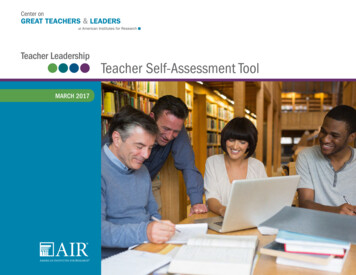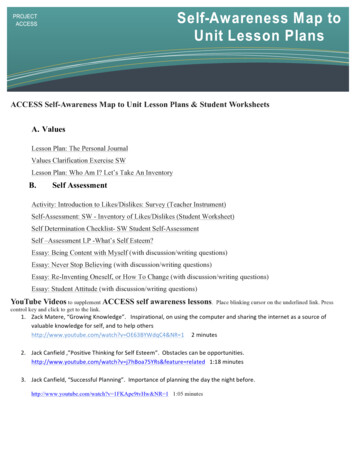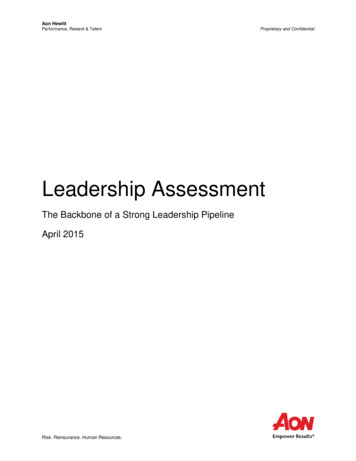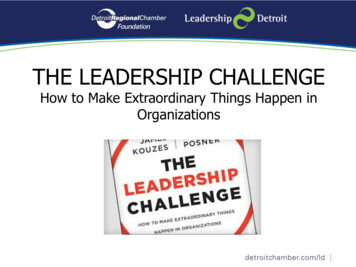
Transcription
Center onGREAT TEACHERS & LEADERSat American Institutes for ResearchTeacher LeadershipMARCH 2017Teacher Self-Assessment Tool
IntroductionAs interest in teacher leadership has grown, many leading organizationsseveral indicators that include possible evidence and look-fors to considerhave developed tools and guidance to support schools, districts, andwhen assigning a rating. Teachers can take this self-assessment toteacher leaders themselves. For instance, the National Network of Statedetermine how they exhibit these foundational and advanced competenciesTeachers of the Year developed resources on teacher leader career pathwaysand identify areas of growth.and advocacy approaches, as well as teacher leader standards. Likewise,the National Board for Professional Teaching Standards developed teacherleadership competencies. Regional educational laboratories also haveworked to better understand teacher leadership, specifically what wecan learn about teacher leadership from the research literature.Instructions. For each indicator, read the primary indicator language andconsider the evidence and look-fors, introduced as “Teacher leaders maydemonstrate this by .” These look-fors are not intended to be all-inclusive;rather, they provide a few examples of how you might demonstrate theindicator in your practice.In collaboration and consultation with the Regional Educational Laboratory(REL) Midwest Educator Effectiveness Research Alliance, REL Midwest andAssign yourself a rating for each indicator, based on the following ratingthe Center on Great Teachers and Leaders developed this tool for teachersscale. You also may write notes or leave comments related to theto self-assess their knowledge, skills, and competencies to serve inspecific indicator.teacher leadership roles. Teachers, working either on their own or withtheir peers, coaches, or evaluators, can use this tool to assess theirNot Evidentdemonstrate a skill.level of readiness for being a teacher leader and develop a planto prepare themselves for leadership.About This ToolREL Midwest researchers conducted a review of the literature on teacherleadership and worked with stakeholders in the Midwestern states to identifyHas not had the opportunity to acquire orBeginningBeginner; has some skills.DevelopingHas some skills; working to master skills.AdvancingHas mastered most skills; still learning and growing.the most critical competencies necessary for successful teacher leadership.The literature and stakeholder input shaped the content of the tool.How to Use the Tool. The teacher leadership competencies in this tool areorganized into four domains (see page 2). Each domain includes severalcompetencies: some are foundational, for teachers who are beginning tothink about leadership roles, and others are advanced, for teachers whoAt the end of each domain, please note the evidence or experience youused to determine the ratings for indicators in the domain. Working onyour own or with peers, coaches, or evaluators, you can use the ratings toreflect on your strengths and areas for growth. You also can identify nextsteps to build on strengths and grow your leadership competencies.are already taking on leadership roles. Each competency is divided intoTeacher Leadership Teacher Self-Assessment ToolCenter on GREAT TEACHERS & LEADERS at American Institutes for Research1
1. COLLABORATION and COMMUNICATION3. INSTRUCTIONAL LEADERSHIPFoundationalFoundational1.1 Developing Positive Relationships and Trust . . . . . . . . . . . . . . 33.1 Demonstrating Pedagogical Knowledge . . . . . . . . . . . . . . . . 191.2 Listening Skills . . . . . . . . . . . . . . . . . . . . . . . . . . . . 53.2 Beginning Coaching Skills . . . . . . . . . . . . . . . . . . . . . . 21Advanced3.3 Demonstrating Social and Emotional Competency . . . . . . . . . . . 231.3 Group Processes, Facilitation, and Coaching Skills . . . . . . . . . . . 73.4 Understanding Data and Research . . . . . . . . . . . . . . . . . . 251.4 Conflict Resolution and Mediation . . . . . . . . . . . . . . . . . . . 9Advanced3.5 Using Data and Research to Improve Practice . . . . . . . . . . . . . 272. PROFESSIONAL LEARNING and GROWTH3.6 Applying Coaching Skills . . . . . . . . . . . . . . . . . . . . . . . 29Foundational2.1 Ongoing Self-Development . . . . . . . . . . . . . . . . . . . . . . 114. SCHOOL COMMUNITY and ADVOCACY2.2 Ongoing Self-Reflection . . . . . . . . . . . . . . . . . . . . . . . . 13FoundationalAdvanced4.1 Supporting and Strengthening the School Community . . . . . . . . . 312.3 Understanding Adult Learning . . . . . . . . . . . . . . . . . . . . . 15Advanced2.4 Facilitating Professional Learning Among Colleagues . . . . . . . . . 174.2 Demonstrating Systems Thinking . . . . . . . . . . . . . . . . . . . 334.3 Building Partnerships . . . . . . . . . . . . . . . . . . . . . . . . . 354.4 Involvement in School Improvement . . . . . . . . . . . . . . . . . . 374.5 Professional Advocacy . . . . . . . . . . . . . . . . . . . . . . . . 39Teacher Leadership Teacher Self-Assessment ToolCenter on GREAT TEACHERS & LEADERS at American Institutes for Research2
1.CULTURE and CONTEXTSubdomainIndicatorsRatingsFoundational Competencies1.1 Developing PositiveRelationshipsand Trust1.1.1: Develop trusting relationships among adults (Center for Strengthening the Teaching Profession [CSTP],2009; Jackson, Burrus, & Roberts, 2010; Leading Educators, 2015).Not EvidentTeacher leaders may demonstrate this byDeveloping “Creating a safe environment” (e.g., by listening to what teachers have to say and providing encouragementand support) for other teachers to take risks (e.g., to try out new practices) and share their experiences(CSTP, 2009).AdvancingBeginning “Model[ing] vulnerability and apologiz[ing] when appropriate to foster authentic, trusting relationships”(Leading Educators, 2015). Developing constructive relationships with teachers and partners (Yukon Education, 2013).1.1.2: Provide and get feedback (Council of Chief State School Officers [CCSSO], 2013; Leading Educators,2015; Yukon Education, 2013).Not EvidentTeacher leaders may demonstrate this byDeveloping Asking for feedback from district and school leaders and implementing feedback for self-improvement.AdvancingBeginning Asking for feedback from other teachers and “critical friends” or colleagues. Providing tactful feedback to other teachers when asked. Establishing feedback mechanisms between colleagues (e.g., one-on-one or with teams through instructionalrounds, professional learning community meetings, co-planning sessions, and coaching sessions).1.1.3: Value diverse opinions (CSTP, 2009).Not EvidentTeacher leaders may demonstrate this byBeginning Asking for others to share their views and opinions.Developing Respecting all perspectives (CSTP, 2009).Advancing Accepting others’ opinions and viewpoints without judgment.Teacher Leadership Teacher Self-Assessment ToolCenter on GREAT TEACHERS & LEADERS at American Institutes for Research3
1.COLLABORATION and COMMUNICATIONSubdomainIndicatorsRatings1.1 Evidence1.1 Next StepsTeacher Leadership Teacher Self-Assessment ToolCenter on GREAT TEACHERS & LEADERS at American Institutes for Research4
1.COLLABORATION and l Competencies1.2 Listening Skills1.2.1: Express interest in others (Jackson et al., 2010).Not EvidentTeacher leaders may demonstrate this byBeginning Paraphrasing responses of teachers (CSTP, 2009; Yukon Education, 2013).Developing Asking clarifying questions of teachers (CSTP, 2009; Yukon Education, 2013).Advancing Asking open-ended questions to teachers (Leading Educators, 2015).1.2.2: Show sensitivity to others (Jackson et al., 2010).Not EvidentTeacher leaders may demonstrate this by acknowledging when it was difficult for someone to share an opinion.BeginningDevelopingAdvancing1.2 EvidenceTeacher Leadership Teacher Self-Assessment ToolCenter on GREAT TEACHERS & LEADERS at American Institutes for Research5
1.COLLABORATION and COMMUNICATIONSubdomainIndicatorsRatings1.2 Next StepsTeacher Leadership Teacher Self-Assessment ToolCenter on GREAT TEACHERS & LEADERS at American Institutes for Research6
1.COLLABORATION and COMMUNICATIONSubdomainIndicatorsRatingsAdvanced Competencies1.3 Group Processes,Facilitation, andCoaching Skills(Center for TeachingQuality, National Boardfor ProfessionalTeaching Standards,& National EducationAssociation, 2014Yukon Education,2013)1.3.1: Run effective meetings (Center for Teaching et al., 2014 CSTP, 2009; Yukon Education, 2013).Not EvidentTeacher leaders may demonstrate this byBeginning Using agendas and meeting notes effectively.Developing Using “technology to enhance communication,” including PowerPoint presentations, conference calls,video conferencing, online document sharing or webinars, and other technology tools (CSTP, 2009).Advancing Enacting a variety of “strategies for setting up spaces, materials, and pacing” that increase participantengagement (CSTP, 2009). “Reading” a group to determine when members are engaged, disengaged, excited, tired, or in agreementor disagreement with the presentation (CSTP, 2009).1.3.2: Use group processes (the processes that people in groups use to solve a problem or make a decision)effectively (CSTP, 2009; Teacher Leadership Exploratory Consortium [TLEC], 2011).Not EvidentTeacher leaders may demonstrate this byDeveloping Using meeting protocols effectively (CSTP, 2009).AdvancingBeginning Establishing and enforcing norms; clearly defining and enforcing group roles and responsibilities. “Moving a group to task completion” (CSTP, 2009). “Help(ing) colleagues make decisions” in a group setting (TLEC, 2011). “Promot(ing) meaningful change” within small groups, large groups, and the school (TLEC, 2011).Teacher Leadership Teacher Self-Assessment ToolCenter on GREAT TEACHERS & LEADERS at American Institutes for Research7
1.COLLABORATION and COMMUNICATIONSubdomainIndicatorsRatings1.3 Evidence1.3 Next StepsTeacher Leadership Teacher Self-Assessment ToolCenter on GREAT TEACHERS & LEADERS at American Institutes for Research8
1.COLLABORATION and COMMUNICATIONSubdomainIndicatorsRatingsAdvanced Competencies1.4 Conflict Resolutionand Mediation1.4.1: Resolve conflict, between both self and colleague, and mediate between other colleagues(Jackson et al., 2010).Not EvidentTeacher leaders may demonstrate this byDeveloping Facilitating difficult conversations.AdvancingBeginning Checking in with teachers involved in conflict resolution. “Model[ing] vulnerability and apologiz[ing] when appropriate to foster authentic, trusting relationships”(Leading Educators, 2015). Promoting diplomacy and actively establishing diplomacy as an expectation to alleviate future conflict.1.4.2: Mediate diverse viewpoints.Not EvidentTeacher leaders may demonstrate this byBeginning “Synthesiz(ing) and summariz(ing)” the opinions of other teachers (CSTP, 2009).Developing “Us(ing) knowledge and understanding of different backgrounds, ethnicities, cultures, and languagesto promote effective interactions among colleagues” (TLEC, 2011).Advancing Actively acknowledging one’s biases and privileges.Teacher Leadership Teacher Self-Assessment ToolCenter on GREAT TEACHERS & LEADERS at American Institutes for Research9
1.COLLABORATION and COMMUNICATIONSubdomainIndicatorsRatings1.4 Evidence1.4 Next StepsTeacher Leadership Teacher Self-Assessment ToolCenter on GREAT TEACHERS & LEADERS at American Institutes for Research10
2.PROFESSIONAL LEARNING and GROWTHSubdomainIndicatorsRatingsFoundational Competencies2.1 Ongoing SelfDevelopment2.1.1: Ensure continuous improvement of practice.Not EvidentTeacher leaders may demonstrate this byBeginning Engaging in a continuous improvement process (CCSSO, 2013; Yukon Education, 2013).Developing Exhibiting/demonstrating a growth mind-set.Advancing2.1.2: Proactively participate in staff development (Yukon Education, 2013).Not EvidentTeacher leaders may demonstrate this byBeginning Engaging regularly in staff development and sharing learnings with others.Developing Intentionally seeking out and advocating for personalizing professional development for self and sharinglearnings with others.AdvancingTeacher Leadership Teacher Self-Assessment ToolCenter on GREAT TEACHERS & LEADERS at American Institutes for Research11
2.PROFESSIONAL LEARNING and GROWTHSubdomainIndicatorsRatings2.1 Evidence2.1 Next StepsTeacher Leadership Teacher Self-Assessment ToolCenter on GREAT TEACHERS & LEADERS at American Institutes for Research12
2.PROFESSIONAL LEARNING and GROWTHSubdomainIndicatorsRatingsFoundational Competencies2.2 OngoingSelf-Reflection2.2.1: Actively engage in and demonstrate ongoing self-reflection (Leading Educators, 2015).Not EvidentTeacher leaders may demonstrate this byBeginning Knowing and acknowledging personal strengths and weaknesses.Developing Being willing to say when they do not know something.Advancing “Reflect[ing] on work style and preferences to improve self-knowledge and effectiveness”(Leading Educators, 2015). “Reflect[ing] on the way actions impact colleagues” (Leading Educators, 2015). Managing personal “thoughts, feelings, and actions to achieve goals” (Public Impact, 2012).2.2.2: Ask for feedback.Not EvidentTeacher leaders may demonstrate this byBeginning Asking for and implementing feedback from district and school leaders.Developing Asking for and implementing feedback from other teachers.Advancing Accepting feedback graciously, even if it includes suggestions for improvement.Teacher Leadership Teacher Self-Assessment ToolCenter on GREAT TEACHERS & LEADERS at American Institutes for Research13
2.PROFESSIONAL LEARNING and GROWTHSubdomainIndicatorsRatings2.2 Evidence2.2 Next StepsTeacher Leadership Teacher Self-Assessment ToolCenter on GREAT TEACHERS & LEADERS at American Institutes for Research14
2.PROFESSIONAL LEARNING and GROWTHSubdomainIndicatorsRatingsAdvanced Competencies2.3 UnderstandingAdult Learning2.3.1: Understand how adult learners differ from students, focusing on the needs, insights, and skillsof adult learners when planning or conducting professional learning activities (CCSSO, 2013).Not EvidentTeacher leaders may demonstrate this byDeveloping Creating a culture of collegiality with a group of teachers (TLEC, 2011).AdvancingBeginning Add specific research to spell out how adult learners differ from student learners. Read different types of adult learners (e.g., elementary versus secondary school teachers).2.3 EvidenceTeacher Leadership Teacher Self-Assessment ToolCenter on GREAT TEACHERS & LEADERS at American Institutes for Research15
2.PROFESSIONAL LEARNING and GROWTHSubdomainIndicatorsRatings2.3 Next StepsTeacher Leadership Teacher Self-Assessment ToolCenter on GREAT TEACHERS & LEADERS at American Institutes for Research16
2.PROFESSIONAL LEARNING and GROWTHSubdomainIndicatorsRatingsAdvanced Competencies2.4 FacilitatingProfessional LearningAmong Colleagues2.4.1: Encourage reflection among colleagues (CCSSO, 2013).Not EvidentTeacher leaders may demonstrate this byBeginning Modeling reflection.Developing Strategically including reflection time in professional learning activities (CSTP, 2009).Advancing2.4.2: “Facilitat[e] professional learning” (CSTP, 2009).Not EvidentTeacher leaders may demonstrate this byBeginning Establishing a trusting climate among colleagues, wherein taking risks and making mistakes is acceptable(CCSSO, 2013).DevelopingAdvancing Creating engaging professional learning that asks colleagues to actively participate. Identifying and “disrupting assumptions” of teachers to support student learning (CSTP, 2009). Anticipating, being aware of, and addressing the needs of teachers; making professional developmentvaluable and useful and matching learning from professional development to teacher and school needs. Tailoring professional learning when necessary to help teachers feel the explicit connections to grade,content, and classroom/school contexts. Fostering teacher buy-in by identifying needs and delivering professional learning based on those needs.2.4.3: Differentiate professional learning for adults at different skill levels.Not EvidentTeacher leaders may demonstrate this by “fostering responsibility for the group’s learning by all group members”(CSTP, 2009).BeginningDevelopingAdvancingTeacher Leadership Teacher Self-Assessment ToolCenter on GREAT TEACHERS & LEADERS at American Institutes for Research17
2.PROFESSIONAL LEARNING and GROWTHSubdomainIndicatorsRatings2.4 Evidence2.4 Next StepsTeacher Leadership Teacher Self-Assessment ToolCenter on GREAT TEACHERS & LEADERS at American Institutes for Research18
3.INSTRUCTIONAL LEADERSHIPSubdomainIndicatorsRatingsFoundational Competencies3.1 DemonstratingPedagogicalKnowledge3.1.1: Use content knowledge and enact high-quality instruction (CSTP, 2009).Not EvidentTeacher leaders may demonstrate this byBeginning Being viewed as an effective teacher by other teachers (Jackson et al., 2010) but with room to grow—willingto make mistakes and learn from them.DevelopingAdvancing Building credibility with peers as an effective teacher. Demonstrating “effective [use of] pedagogical strategies in the classroom” (CTSP, 2009). Effectively implementing teaching skills and pedagogical knowledge of his or her subject area(Jackson et al., 2010). “Promot[ing] instructional strategies that address issues of diversity and equity in the classroom (TLEC, 2011). Ensur[ing] that individual student learning needs remain the central focus of instruction” (TLEC, 2011).3.1.2: Engage in effective assessment (CSTP, 2009).Not EvidentTeacher leaders may demonstrate this byBeginning Understanding various formative and summative assessment methods (TLEC, 2011).Developing Selecting and implementing assessment strategies aligned with the curriculum (CTSP, 2009).Advancing Consistently checking for student understanding using multiple formats during classroom instruction. Using data from students’ informal and formal assessment to track student progress (e.g., growth towardstudents’ learning goals or standards). “Work[ing] with colleagues to use assessment and data findings to promote changes in instructional practicesor organizational structures to improve student learning” (TLEC, 2011).Teacher Leadership Teacher Self-Assessment ToolCenter on GREAT TEACHERS & LEADERS at American Institutes for Research19
3.INSTRUCTIONAL LEADERSHIPSubdomainIndicatorsRatings3.1 Evidence3.1 Next StepsTeacher Leadership Teacher Self-Assessment ToolCenter on GREAT TEACHERS & LEADERS at American Institutes for Research20
3.INSTRUCTIONAL LEADERSHIPSubdomainIndicatorsRatingsFoundational Competencies3.2 BeginningCoaching Skills3.2.1: Improve the practice of other teachers.Not EvidentTeacher leaders may demonstrate this byBeginning Opening up their classroom to observation by other teachers to share best practices and “model effectiveinstructional strategies for colleagues” (CCSSO, 2013).DevelopingAdvancing “Facilitating growth-oriented dialogue about instruction” (Boston Teacher Leadership Certificate [BTLC]Program, 2013). “Expanding colleagues’ instructional resources and routines” (e.g., identifying “instructional resourcesor routines that can be adopted or adapted to address the problem of practice your team is working on”and “try them yourself” (BTLC Program, 2013).3.2 EvidenceTeacher Leadership Teacher Self-Assessment ToolCenter on GREAT TEACHERS & LEADERS at American Institutes for Research21
3.INSTRUCTIONAL LEADERSHIPSubdomainIndicatorsRatings3.2 Next StepsTeacher Leadership Teacher Self-Assessment ToolCenter on GREAT TEACHERS & LEADERS at American Institutes for Research22
3.INSTRUCTIONAL LEADERSHIPSubdomainIndicatorsRatingsFoundational Competencies3.3 DemonstratingSocial and EmotionalCompetency3.3.1: Create a supportive classroom climate.Not EvidentTeacher leaders may demonstrate this byBeginning Cultivating a classroom culture that values student collaboration.Developing Modeling emotionally supportive behavior in the classroom.Advancing Reinforcing emotionally supportive behavior exhibited by students.3.3.2: Supporting student social and emotional learning.Not EvidentTeacher leaders may demonstrate this byBeginning Understanding the social and emotional needs of students (e.g., feeling safe and supported at schooland experiencing meaningful relationships with adults and peers at school).DevelopingAdvancing Addressing student social and emotional needs, in addition to academic standards, in the classroom.3.3.3: Demonstrate strong classroom organization.Not EvidentTeacher leaders may demonstrate this byBeginning Promoting strong student engagement in the classroom.Developing Implementing successful rules and routines in the classroom.Advancing Engaging in management techniques that keep students in the classroom and focused on the lesson,not in the office or out of school. Organizing time and resources for maximum effectiveness (Leading Educators, 2015).Teacher Leadership Teacher Self-Assessment ToolCenter on GREAT TEACHERS & LEADERS at American Institutes for Research23
3.INSTRUCTIONAL LEADERSHIPSubdomainIndicatorsRatings3.3 Evidence3.3 Next StepsTeacher Leadership Teacher Self-Assessment ToolCenter on GREAT TEACHERS & LEADERS at American Institutes for Research24
3.INSTRUCTIONAL LEADERSHIPSubdomainIndicatorsRatingsFoundational Competencies3.4 Understanding Dataand Research3.4.1: Understand how to use data (BTLC Program, 2013).Not EvidentTeacher leaders may demonstrate this byBeginning Showing “the ability to analyze both subject matter concepts and pedagogical strategies” (CSTP, 2009).Developing “Collaborat[ing] with colleagues in the design, implementation, scoring, and interpretation of student datato improve educational practice and student learning” (TLEC, 2011).Advancing3.4.2: Understand educational research (TLEC, 2011).Not EvidentTeacher leaders may demonstrate this by reading and being aware of new educational research.BeginningDevelopingAdvancing3.4 EvidenceTeacher Leadership Teacher Self-Assessment ToolCenter on GREAT TEACHERS & LEADERS at American Institutes for Research25
3.INSTRUCTIONAL LEADERSHIPSubdomainIndicatorsRatings3.4 Next StepsTeacher Leadership Teacher Self-Assessment ToolCenter on GREAT TEACHERS & LEADERS at American Institutes for Research26
3.INSTRUCTIONAL LEADERSHIPSubdomainIndicatorsRatingsAdvanced Competencies3.5 Using Data andResearch toImprove Practice3.5.1: Apply educational research (TLEC, 2011).Not EvidentTeacher leaders may demonstrate this byBeginning Identifying relevant practices from educational research and applying them in the classroom or on the job.Developing “Assist[ing] colleagues in accessing and using research in order to select appropriate strategies to informstudent learning” (TLEC, 2011).Advancing “Teach[ing] and support[ing] colleagues [in] collect[ing], analyz[ing], and communicat[ing] data from theirclassrooms to improve teaching and learning” (TLEC, 2011).3.5.2: Engage in a data reflection cycle.Not EvidentTeacher leaders may demonstrate this byBeginning Analyzing data regularly as part of individual reflection on practice.Developing Changing practices based on data analysis.Advancing Engaging in and sharing the results of action research conducted alone or collaboratively (CCSSO, 2013).3.5.3: Use data to inform decision making (BTLC Program, 2013) and help others to use data to make decisions.Not EvidentTeacher leaders may demonstrate this byBeginning “Facilitat[ing] and leading the collection, analysis, and use of classroom- and school-based data to identifyopportunities to improve curriculum, instruction, assessment, school organization, and school culture”(TLEC, 2011).DevelopingAdvancing “Engag[ing] in reflective dialog with colleagues based on observation of instruction, student work, andassessment data and help[ing] to make connections to research-based effective practices” (TLEC, 2011). Modeling data collection, analysis, and reflection and how they should lead to changes in practice (TLEC, 2011).Teacher Leadership Teacher Self-Assessment ToolCenter on GREAT TEACHERS & LEADERS at American Institutes for Research27
3.INSTRUCTIONAL LEADERSHIPSubdomainIndicatorsRatings3.5 Evidence3.5 Next StepsTeacher Leadership Teacher Self-Assessment ToolCenter on GREAT TEACHERS & LEADERS at American Institutes for Research28
3.INSTRUCTIONAL LEADERSHIPSubdomainIndicatorsRatingsAdvanced Competencies3.6 ApplyingCoaching Skills3.6.1: Provide constructive and actionable feedback (TLEC, 2011).Not EvidentTeacher leaders may demonstrate this byBeginning Coaching other teachers in how to improve instruction.Developing Ensuring that feedback provided to other teachers is constructive and actionable.Advancing3.6.2: Lead conversations that prompt self-reflection.Not EvidentTeacher leaders may demonstrate this byBeginning Modeling reflection in conversations and in professional development opportunities.Developing Intentionally building time into professional development opportunities for teachers to reflect on practice.Advancing3.6 EvidenceTeacher Leadership Teacher Self-Assessment ToolCenter on GREAT TEACHERS & LEADERS at American Institutes for Research29
3.INSTRUCTIONAL LEADERSHIPSubdomainIndicatorsRatings3.6 Next StepsTeacher Leadership Teacher Self-Assessment ToolCenter on GREAT TEACHERS & LEADERS at American Institutes for Research30
4.SCHOOL COMMUNITY and ADVOCACYSubdomainIndicatorsRatingsFoundational Competencies4.1 Supporting andStrengthening theSchool Community4.1.1: Participate in school initiatives.Not EvidentTeacher leaders may demonstrate this byBeginning Serving as an active participant in school initiatives, including school improvement efforts.Developing Expressing interest in leading school improvement efforts.Advancing4.1.2: Create a welcoming environment (Yukon Education, 2013).Not EvidentTeacher leaders may demonstrate this by supporting an open school environment that is receptive to theinvolvement of families and community members (Yukon Education, 2013).BeginningDevelopingAdvancing4.1.3: Advocate for students.Not EvidentTeacher leaders may demonstrate this byBeginning Ensuring that student success is the focus of any conversation among teachers and leaders about students.Developing Working to ensure that their students receive the necessary services and supports.Advancing4.1.4: Demonstrate respect for diverse cultures (TLEC, 2011).Not EvidentTeacher leaders may demonstrate this byBeginning Encouraging opportunities for diverse voices to be heard from students, families, and colleagues.Developing Fostering opportunities to teach and learn about diversity.AdvancingTeacher Leadership Teacher Self-Assessment ToolCenter on GREAT TEACHERS & LEADERS at American Institutes for Research31
4.SCHOOL COMMUNITY and ADVOCACYSubdomainIndicatorsRatings4.1 Evidence4.1 Next StepsTeacher Leadership Teacher Self-Assessment ToolCenter on GREAT TEACHERS & LEADERS at American Institutes for Research32
4.SCHOOL COMMUNITY and ADVOCACYSubdomainIndicatorsRatingsAdvanced Competencies4.2 DemonstratingSystems Thinking4.2.1: Understand local, regional, and national education trends.Not EvidentTeacher leaders may demonstrate this byBeginning Understanding how educational policy is made at the local, state, and national levels.Developing Explaining to other teachers relevant education trends, such as college and career readiness standardsor the Every Student Succeeds Act.Advancing Explaining to other teachers the impact of relevant district initiatives.4.2 EvidenceTeacher Leadership Teacher Self-Assessment ToolCenter on GREAT TEACHERS & LEADERS at American Institutes for Research33
4.SCHOOL COMMUNITY and ADVOCACYSubdomainIndicatorsRatings4.2 Next StepsTeacher Leadership Teacher Self-Assessment ToolCenter on GREAT TEACHERS & LEADERS at American Institutes for Research34
4.SCHOOL COMMUNITY and ADVOCACYSubdomainIndicatorsRatingsAdvanced Competencies4.3 Building Partnerships(Yukon Education,2013)4.3.1: Partner with families (TLEC, 2011; Yukon Education, 2013).Not EvidentTeacher leaders may demonstrate this byBeginning “Promot[ing] regular, ongoing collaboration with families” by teachers (TLEC, 2011; Yukon Education, 2013).Developing Encouraging others to engage in regular, ongoing collaboration with families.Advancing Viewing family members as partners in a child’s education, treating them with respect in all circumstancesand respecting their backgrounds.4.3.2: Partner with other stakeholders (TLEC, 2011; Yukon Education, 2013).Not EvidentTeacher leaders may demonstrate this byBeginning “Promot[ing] ongoing systematic collaboration with community members, business and community leaders,and other stakeholders to improve the educational system and expand opportunities for student learning”(TLEC, 2011).DevelopingAdvancing Enhancing and extending collaboration with other stakeholders through outreach and partnerships (YukonEducation, 2013).Teacher Leadership Teacher Self-Assessment ToolCenter on GREAT TEACHERS & LEADERS at American Institutes for Research35
4.SCHOOL COMMUNITY and ADVOCACYSubdomainIndicatorsRatings4.3 Evidence4.3 Next StepsTeacher Leadership Teacher Self-Assessment ToolCenter on
Teacher Leadership Teacher Self-Assessment Tool Center on GREAT TEACHERS & LEADERS at American Institutes for Research 2 1. COLLABORATION and COMMUNICATION Foundational 1.1 Developing Positive Relationships and Trust . .3 1.2 Listening Skills . .5 Advanced 1.3 Group Processes, Facilit










